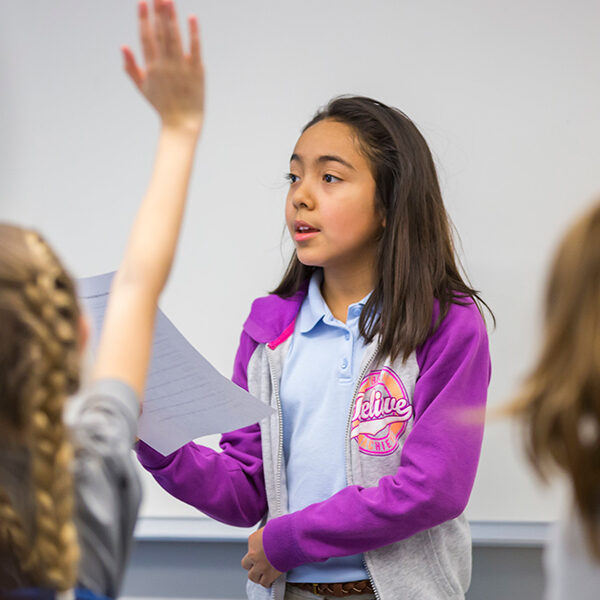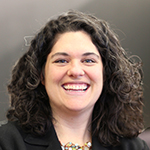
“What if you could eradicate the fear of public speaking? We’re working to design a virtual reality program to help people get over that fear.”
The high school students making this pitch seem to have benefited from their own innovation. They are poised and clear-spoken, standing on the stage speaking into a microphone to a room full of students, teachers, district leaders, entrepreneurs and other education professionals. Not all the students at the Learning Innovation Showcase at LearnLaunch’s Across Boundaries conference are so at ease, but they are engaged. This is an opportunity for 20 student groups from schools across Massachusetts to publically showcase their technology-assisted learning and inventions to conference attendees and, importantly, to each other.
The showcase has a science fair-like atmosphere, including the tables topped with posterboard, flyers, laptops and student-made product samples. The students’ energy is also familiar – simultaneously nervous and confident as they describe their work. Tom Rooney, the Superintendent of Lindsay Public Schools in California and one of the conference’s keynote speakers, sits quietly in the back row of chairs in front of the stage, listening to the student pitches. That morning he had spoken about the need to expand school curriculums to genuinely engage students, and these projects are prime examples. A new group gets up and performs a sardonic skit about media literacy. “Everything on Wikipedia is true, right? I learned there that the Sun revolves around the Earth. Come to our booth to learn how to source authentically.”
A number of opinion pieces have surfaced in the last year questioning the value of students using technology in their classrooms, worrying that it may be doing more harm than good. But discussions with these students and their teachers last week demonstrate how much nuance there is inside this debate and how far students can go when they have access to the tools that match the sophistication of their ideas.
Three things, in particular, stood out:
1. Relationships Between Students and Teachers are Key
A soft-spoken girl named Janai stands calmly next to a computer showing an online math program. Jenai talks about how she feels in control of her learning in a way she never has before by using it. Her teacher from Davis Leadership Academy, who introduces himself as Josh, talks about the way the software integrated in the Google Classroom they set up over the summer – which, according to him, evaporated the typical summer learning slump. “We generated a real math conversation throughout the summer. By the end, the students were having natural dialogue.” Josh talks to Janai like a peer as they explain the program to me. The respect between them is evident.
Representing Norton Middle School, two girls who introduce themselves as Emma and Katie are eager to show off tactile books they have created using a 3D printer. Each book has braille lettering as well as raised pictures of objects you can “see” with your fingers. They explain that they created these books on their own time, before school started, over a period of weeks with the aid of a supportive teacher. Their books have been catalogued by their local library and one has been translated into Spanish.
In both cases, teacher support was vital for student success – not by delivering content, but by acting as advisors, cheerleaders and even co-learners. This support role enabled student creativity and achievement to thrive, in part by providing a safe space for students to take risks with their ideas.
2. Student Agency Helps Innovation Thrive
Another theme that surfaced at the Innovation Showcase was the importance of students’ driving their own work. Two students, Josh and Amith from Meadowbrook School, illustrate this point as they show off the WordPress site that housed their school newspaper. “I can show you the back end, if you want,” Josh offers. I ask what brought them to the conference and Josh responds, “I like to write but not when there’s a grade attached and not when I can’t pick the topic. The newspaper gave me that chance.” Their teacher, standing to the side, explains that they teach digital citizenship, but the newspaper belongs to the students. “It’s about them following their own interests.”
The variety of ideas and subjects the students have tackled reveal a set of interests far beyond the average English, Math, or History class. Virtual reality programs, scientific experiments, and entrepreneurial projects all emerged from student visions for what they wanted to learn and produce. It’s a good reminder that few students are “always engaged” or “always disengaged.” By pairing agency with support, teachers help open the door for students who may shut down in more traditional school environments but thrive when they have authentic options.
3. When Given Choices, Students Tackle Real Problems
Student groups at the Innovation Showcase seemed to be primarily motivated by the ability to tackle real-world problems. Students from Andover High School, for example, focus on energy production. “We want to harness the power of the water wheel and modernize it for the 21st century.” In Boston Public Schools, students have created a youth voices program to share student ideas and opinions online. Students at Beaver Country Day explain that they have used a 3D printer to make a prosthetic hand to see if they can lower costs for future patients.
This calls into question the view that students can’t tackle complex problems until after they’ve learned all the related relevant content, or that somehow delivering enough information through lecture will spur motivation to learn more. These students show us that the opposite might be true – by tackling real problems, students will spend more time researching the relevant content areas because they are motivated to find a solution that feels meaningful to them. Emma and Katie did not produce multiple versions of their tactile books because their teacher told them to. They refined them because they cared about having a finished product that their library would be proud to catalogue. Their next step, they say, is testing their books with real users.

